create a triple win by trying NPD “yes, and” with retail buyers
by: Becky Mead
NPD works best when retailers, manufacturers and consumers are in alignment. However, this isn’t always the case. Often, retail buyers make innovation requests that aren’t rooted in consumer insight. Manufacturers want their products ranged, so they steam ahead without seeking consumer validation. The result? Crossing the finish line with a product that flops.
In this situation, everyone loses. The buyer is unhappy. Consumers miss out. But the manufacturer hurts most because they’ve put money into developing a dud. They’ve paid for artwork, packaging, raw materials, new equipment and more. They’ve also potentially contorted themselves to meet a brief that doesn’t match the brand.
I want to propose a solution to this problem. A simple solution that keeps all parties smiling.

follow the first rule of improv
What’s the first rule of improv? "Yes, and". This creative exercise encourages actors to agree with a proposition before building on it for the better. In this case, when a retail buyer offers an idea based on an overseas trend or personal passion, the manufacturer says, “Yes, let's look into that suggestion, and wouldn’t it be wonderful to explore X too...”.
This collaborative approach fosters creativity and avoids either party feeling shut down or unheard. By saying “yes" and suggesting additional ideas, you've found a non-confrontational way to present a real opportunity. You can then use this opportunity to uncover what the category and consumers really need.
Both retail buyers and manufacturers bring a lot to the innovation table. The best result comes from combining that expertise and validating it with consumer input. Evidence always wins over clashing opinions. (Or it should do.)
the proof is in the product ideas
Part of your “yes” could be testing the retail buyer’s idea. After all, they might be right on the money. However, an essential part of this process is exploring the “and”. I suggest testing at least five related ideas that have the potential to come out on top.
Perhaps the buyer suggests a sweet cracker. The manufacturer could say, “Great! Thanks for that idea, and you know what? We’ve also done some work around cheesy pretzels and bite-size snacks. The results showed us that X ideas are more compelling to everyday snacking consumers.” You could even build on the buyer’s idea with thoughts related to category trends. Maybe it’s worth investigating reduced sugar options, portion packs or sweet biscuits instead.
Use the buyer’s inspiration to kickstart your ideation. Next, conduct research to uncover relevant insights into local emerging trends with mainstream appeal. Finally, leverage those insights to make a product that suits your brand and sells like hotcakes to happy customers.

pinning down purchase drivers
Here’s what I recommend when dabbling in this kind of data. Firstly, a usage and attitudes (U&A) study will help you understand consumer needs and drivers in the category. These findings will allow you to guide a discussion around emerging needs and untapped opportunities.
If the buyer comes to you with a fixed idea, you can ideate around the opportunity and return with multiple options for a concept test. This research would tell you which concepts have the highest purchase intent. It would also enable you to share interesting behavioural insights.
Later down the line, you could perform prototype testing. Perhaps the buyer wants to develop a low-salt peanut butter. You could produce a range of peanut butters that vary in terms of salt, sugar, texture and additional ingredients. Lastly, taste the prototypes and see what sticks (not just to your mouth!).
don’t turn tomato red
Here’s a real-world example to illustrate my point. A retailer once asked a tomato grower to make their containers easier to carry by adding a handle. The tomato grower spent millions of dollars on machinery to do the job. Within six weeks, the retailer reported that the new packaging wasn’t selling better than the regular tubs. The tomato grower was asked to revert to the old design. Ouch.
“Yes, and” would have worked wonders here. Clearly, convenience was a driver. How else could the grower have satisfied an unmet need without engineering something new? Would a stick-on handle or stronger resealable lid have sufficed? Ultimately, consumers could have validated that a handle wouldn’t have driven purchase intent.
Side note: If you decide to take a chance on something new, always dip your toe in the water. Keep expenses to a minimum and tread lightly until you get the green light from consumers.
partners in product development
Proactivity is the key to keeping everyone happy. As a manufacturer, take charge of the relationship with your retail buyer by offering them a three to five-year view of the category. Keep your finger on the pulse about emerging trends in terms of flavours, packaging and consumer drivers. Remain ready to inform and inspire.
Ultimately, taking your buyer on a journey through the NPD process will deepen the partnership and grow trust for the future. It will also open the door for you to approach them with ideas that align with your business and consumer needs. That’s what I like to call “a triple win”.
Need help putting “yes, and” into practice? The PLAY Innovation team are experts in identifying consumer-led opportunity areas to ensure you create new products that are shelf-winners, not shelf-warmers. Email me at becky@playinnovation.com.au to get started.
Author byline:
Becky Mead
Managing Director, PLAY Innovation
Becky has spent the last 18 years getting curious about understanding consumers so FMCG manufacturers can create products they truly want. Becky’s favourite part of the job is helping businesses leverage the consumer perspective to grow - fast! She believes in the benefits of working in partnership with her clients across the entire innovation process and focuses on consumer-first, agile approaches.
read it, love it, share it.
about the author
Becky Mead
Becky has spent the last 20 years getting curious about understanding consumers so FMCG manufacturers can create products they truly want. Becky’s favourite part of the job is helping businesses leverage the consumer perspective to grow - fast! She believes in the benefits of working in partnership with her clients across the entire innovation process and focuses on consumer-first, agile approaches.



ask the author